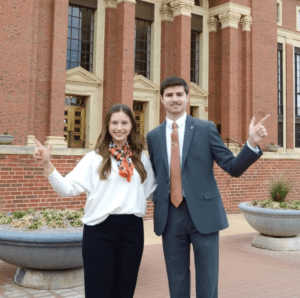Since its start in 2019, March To The Madness has grown from raising $28,000 toward the Annual Loyalty Fund to $83,000 in 2021. This fundraiser, modeled after the NCAA March Madness Basketball Tournament, is not only becoming popular throughout Sigma Alpha Epsilon but has also sparked interest among other Greek organizations.
Why is March to the Madness gaining so much popularity? As SAE Foundation Vice Chairman Tom LaMantia likes to say, “This
is FUNraising.” March to the Madness is a friendly competition among chapters in support of the Sigma Alpha Epsilon
Foundation. What’s at stake? Aside from your chapter’s name added to the official March to the Madness trophy at the Levere Memorial Temple, the ultimate prize is, you guessed it, bragging rights!
The tournament is set up bracket-style, with chapters competing against each other one-on-one to raise the most money in each
12-hour game. When the buzzer sounds, the chapter with the most money raised advances to the next round.* Sounds pretty
straightforward, right? Yes, until your opponent shoots in the last second of the game and makes a huge donation for the win.
That’s why every chapter needs a strategy and a team captain to organize it. The key to success is a strong leader who can rally
the chapter’s alumni base and, as with any team sport, captains don’t win a March to the Madness championship alone. Not only do
teams need captains, but also dependable co-captains to recruit alumni donors from their classes. All of 2021’s Final Four team captains agreed that chapters should start planning early and recruit co-captains to assist with outreach.
University of Texas-Dallas alumnus James Balandrán says, “A lot of it is just rallying their alumni base and reconnecting with people, and getting a team of people together to rally their own classes and groups. Because one person can’t get their entire chapter to donate, right? It has to be a group effort.”
Likewise, Nathan Crunkilton of Winthrop University says, “I think the one thing I would have done differently was reach out to people earlier in the year. A lot of it was scrambling that last three hours, especially against Indiana.” Additionally, team captains are essential in organizing a strategy and evolving from year to year.
Indiana University alumnus and SAE Foundation CEO Steve Mitchell describes watching future opponents play the game to know
what to expect when his team is against them. Do their donations come in throughout the day or towards the end of the round? Does one donor always contribute, and at what time usually? Does the team wait until the last minute of the match to make a
large contribution? Steve says, “We’ve been in it since the beginning, and you just learn over time how to compete in the event.”
Nathan recalls the feeling of victory after a nail-biting final two minutes of last year’s Elite 8 match-up between Winthrop and
Central Michigan. Neither team had donated with 15 minutes to go in the round. As team captain, Nathan coordinated a strategy
via a Zoom meeting where several members had donations pulled up and ready to go. At the same time, another few
watched the clock or refreshed the webpage to track Central Michigan’s donations.“We ended up beating them by about $400, and I think between the two chapters, we raised about $2,000 in two minutes. It was just a really refreshing and really energizing feeling to be able just to get that two minutes of excitement to know that we beat them on that, and it took us to the Final Four as well, so we were really excited about that.”
Aside from getting wrapped up in the competition, another unintended consequence of this FUNraiser is the connections
made between brothers. Steve describes reconnecting with brothers saying, “You have no idea about the number of people you’ll talk to that you haven’t spoken to in years and just how much fun it’s going to be.”
When asked, “Would you say that it was fun for you to be the team captain?” James said, “For sure. It was a good time to get
everybody back together. We had a lot of participation. Even when we made it to the finals, a lot of our older alums just started
sending out emails.”
Similarly, SAE Foundation Trustee and Oklahoma team captain Jack Counts said, “It’s satisfying when you get a lot of people to
contribute. Honestly. That’s what’s really cool about it. You get a lot of people psyched up. You start getting communications
back. I mean, it’s one thing to be sending out emails to people. When you start to get feedback – Where are we? What’s the
status? You know, things like that. You know you’ve got people interested and involved.”
If you still need some convincing to participate, Steve says, “It’s a ton of fun. I mean, it’s a game, right? You just get so caught up
in it.”
Click here to sign up to be a Team Captain!
*2022’s tournament will feature two wild cards in the Round of 64 and one wild card in the Round of 32. Wild card teams are the losing team(s) with the most dollars raised in that round. The wild card team(s) will replace the winning team(s) that raised less than the wild card, therefore, taking that team’s position in the bracket.















